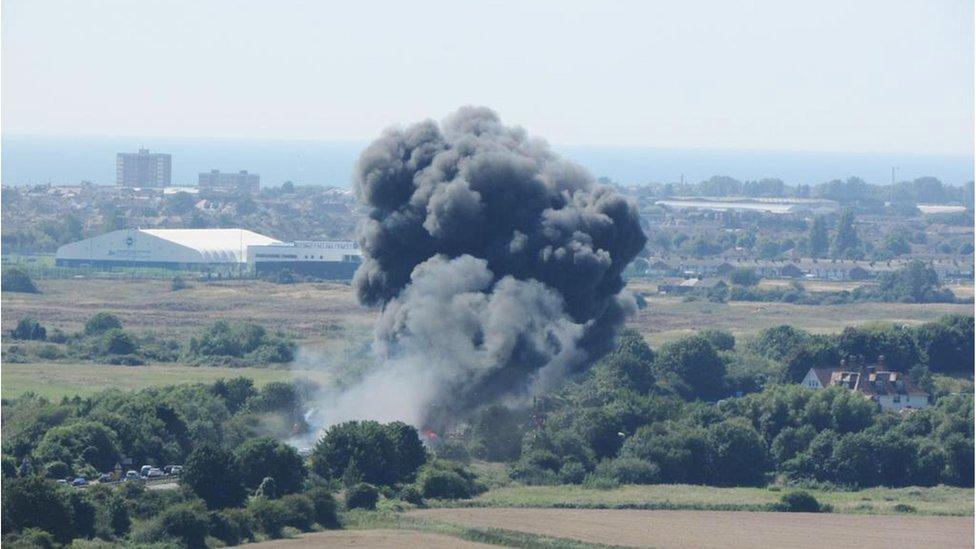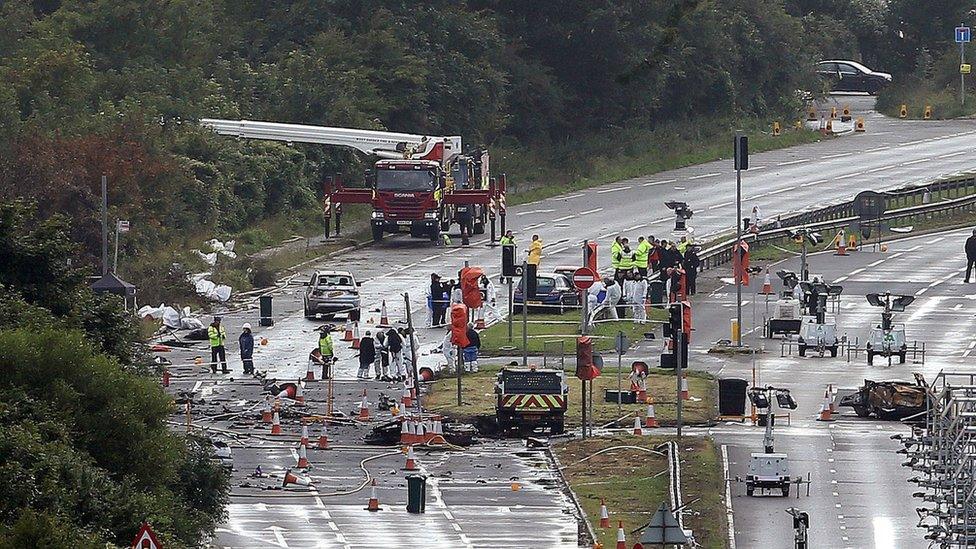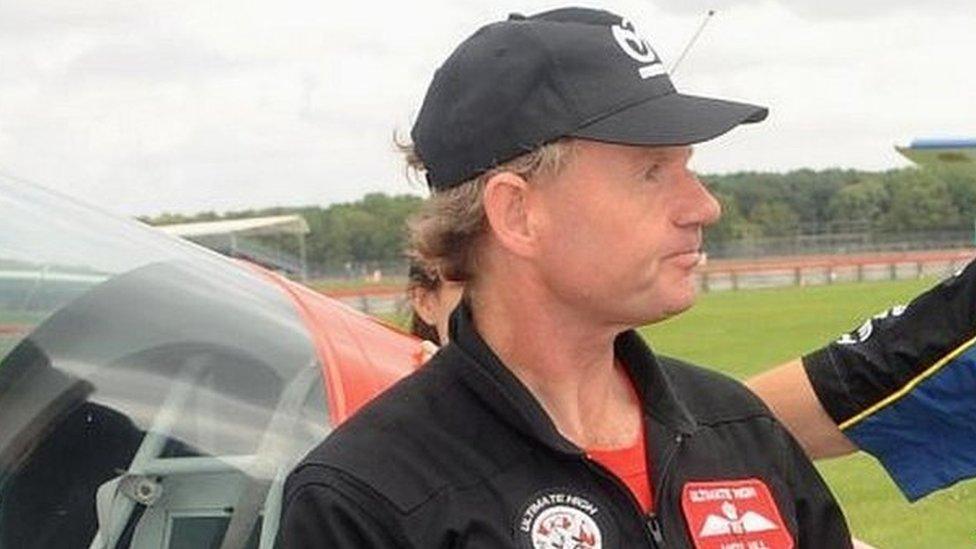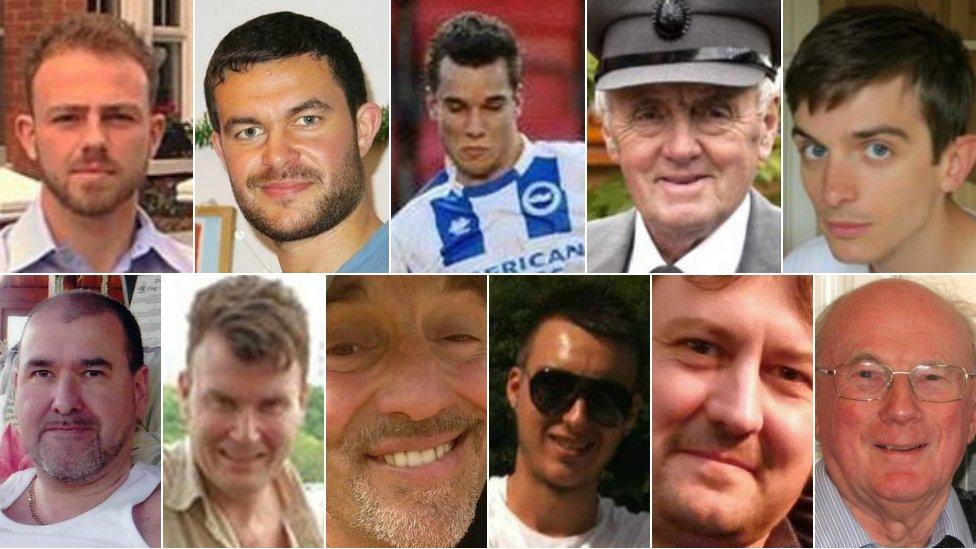Shoreham air crash trial: Pilot Andy Hill 'did nothing' to avoid crash
- Published
The Hawker Hunter crashed into A27 in Shoreham
A pilot was "doing nothing" to avoid crashing his jet at the Shoreham Airshow killing 11 men, a court heard.
Witness Derek Davis said it was obvious something was wrong with Andy Hill's flight, with another witness saying the pilot had made a "gross error... thousands of feet too low".
Mr Hill, 54, is on trial after his Hawker Hunter crashed on the A27 erupting into a "massive fireball".
He denies 11 counts of manslaughter by gross negligence, in August 2015.

The court heard the aircraft erupted in a "massive fireball" when it hit the ground
Mr Davis, a former RAF flight instructor and chairman of the air show's flying control committee, told the court he only realised something was wrong when the plane began to descend as part of a bent-loop manoeuvre.
The move had earlier been described as "perhaps the highest risk manoeuvre in an aircraft which is not designed as a pure aerobatic aircraft", such as a Hawker Hunter.
Mr Davis said the way in which the plane was "waffling down" towards the ground indicated "there is something wrong with either the aircraft or the pilot".
"He was not desperately trying to miss the ground or anything. He was doing nothing," Mr Davis told the jury.
"I thought the aircraft on the descent was not being controlled," Mr Davis said.
Crash 'inevitable'
Asked what led to his concern, he said: "He did not apply power which would have been needed.
"There was no noise. The pilot did not make any radio transmission that he had a problem.
"If he thought something was wrong he could tell somebody," he said.
"It didn't jettison the canopy. He didn't explode the hood off or anything."
He said it appeared to him as though Mr Hill was able to pull back on the plane's "stick" and attempt to avoid a crash.
Asked why he did not call a stop to the display at that point, Mr Davis replied: "The situation when you see an aircraft in trouble or doing something extremely unusual it could well be that there is something wrong inside that aircraft."
"It could well be that the pilot is working extremely hard to rectify that."
He said a call to the pilot could "interfere" with his attempts to deal with a fault.
'Too low for recovery'
RAF squadron leader Daniel Arlett told the court that as Mr Hill made the fateful manoeuvre he was "thousands of feet" too low and had made "a massive gross error".
Mr Arlett, who led a team of display pilots at the time and assessed Mr Hill before he joined the squad, described the defendant as an "expert pilot".
He said he first had concerns when he realised the Hawker Hunter was suddenly unusually quiet.
He said that as Mr Hill began the final manoeuvre he realised the plane was "too low for a looping manoeuvre recovery".
"We are talking thousands of feet low. This is a massive, gross error."
He said the jet had appeared to "flop" over at the top of the loop.
"It felt like it was just the gravity pushing it down," he told the jury.
"As soon as I knew the nose was pointing down there was only one ending going to happen."

The Hawker Hunter jet plummeted on to the A27 on 22 August 2015
Thomas Moloney, an experienced display pilot who once owned the crashed aircraft but had never flown it, witnessed the manoeuvre.
He told the court he had experienced a "sickening feeling" when he saw the plane pull upwards, because "the pilot has not attained sufficient speeds to pull into vertical".
"When the aircraft went vertical I sort of felt that it was not going to end very well," he told the jury.
"I said to the pilot standing next to me, a friend of mine, 'God he's slow'.
"As the nose dropped the crash was inevitable."
One of the first medics on the scene, Red Cross nurse Tony Kemp, said he found Mr Hill lying on the ground, with his helmet removed.
He described the pilot as "semi-conscious and able to respond".
"He had quite a lot of blood around his face, coming from a head wound," the court heard.
He said he was "responsive and somewhat combative", and "having difficulty understanding all that we were saying".

Andy Hill had "responded professionally" to errors made at previous air shows, the court heard
Mr Hill attempted to push away an oxygen mask but this was "purely down to his [medical] condition", Mr Kemp said.
"Mr Hill suddenly crashed very seriously. He was about to have a cardiac arrest."
The nurse inserted a needle into Mr Hill's chest to relieve a build up of air, from a "life-threatening puncture to his lung", the court heard.
He was then administered a dose of ketamine, becoming "sedated pretty well immediately," before being taken to hospital.
The trial is expected to last up to seven weeks.

(Top row, left to right) Matt Jones, Matthew Grimstone, Jacob Schilt, Maurice Abrahams, Richard Smith. (Bottom row, left to right) Mark Reeves, Tony Brightwell, Mark Trussler, Daniele Polito, Dylan Archer, Graham Mallinson
The men who died
Matt Jones, a 24-year-old personal trainer
Daniele Polito, 23 was travelling in the same car as Mr Jones
Matthew Grimstone, 23, a Worthing United footballer who worked as a groundsman at Brighton & Hove Albion
Jacob Schilt, also 23 and also a Worthing United player, was travelling to a match with Mr Grimstone
Maurice Abrahams, 76, from Brighton, was a chauffeur on his way to pick up a bride on her wedding day
Friends Richard Smith, 26, and Dylan Archer, 42, who were going for a bike ride on the South Downs
Mark Reeves, 53, had ridden his motorcycle to the perimeter of Shoreham Airport to take photos of the planes
Tony Brightwell, 53, from Hove was an aircraft enthusiast and had learnt to fly at Shoreham airfield
Mark Trussler, 54, had gone to watch the display on his Suzuki motorbike and was standing next to the road
James "Graham" Mallinson, 72, from Newick, was a photographer and retired engineer
- Published17 January 2019

- Published16 January 2019
